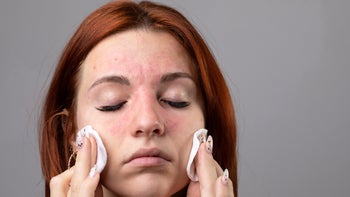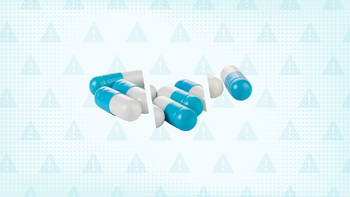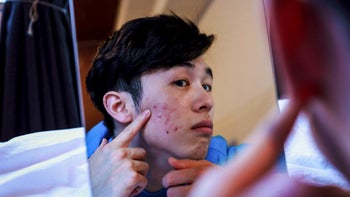
How to Choose the Best Antibiotic for Acne: Options, Side Effects, and Risks
Key takeaways:
Antibiotics are a safe and effective treatment for a type of acne called inflammatory acne.
For mild inflammatory acne, antibiotic creams, gels, or wipes can work. Erythromycin and clindamycin are two good options.
For more severe acne, you’ll likely need antibiotic pills, such as minocycline, erythromycin, or doxycycline.
Antibiotics work best when they are combined with other acne medications. This also helps prevent antibiotic resistance.
Table of contents

Many doctors prescribe antibiotics for acne, but do they really work? And which antibiotic is best?
Antibiotics are a safe and effective treatment choice for inflammatory acne, which is when you have pimples, pustules, or deep, painful cysts.
If you just have comedonal acne — meaning whiteheads or blackheads — antibiotics are not your best option.
Search and compare options
When it comes to antibiotic treatment for inflammatory acne, there are lots of choices. So it can be hard to know what the best option is for you. Here we’ll take a closer look at which antibiotics are most effective against acne and any precautions you need to take when using them.
How do antibiotics work to treat inflammatory acne?
To understand how antibiotics work to treat acne, it helps to know how acne starts.
First, dead skin cells and oil clog up the pores. This causes comedonal acne, which includes whiteheads and blackheads. But clogged pores can then attract certain strains of bacteria that naturally live on the surface of the skin.
Once trapped in a pore, these bacteria multiply and cause the pore to become inflamed. If the inflammation goes deep into the skin, pimples, cysts, or nodules appear. When this happens, it’s called inflammatory acne.
Antibiotics work by fighting the acne-causing bacteria, either by stopping the bacteria from growing or killing them altogether. Antibiotics can also help reduce the inflammation that bacteria cause in the skin.
A complete treatment plan for inflammatory acne will usually involve antibiotics in combination with other acne treatments, such as a topical retinoid. You can read more about combining antibiotics with other acne medications below.
Antibiotics that treat inflammatory acne
There are a few different antibiotics that can treat inflammatory acne, and they come in various forms. Topical antibiotics are those that come in the form of creams, gels, or wipes, and you apply them directly onto your skin. Oral antibiotics come in pills or liquids, and they work throughout your body.
Which type of antibiotic you use depends on how severe your acne is. Treatment for mild inflammatory acne typically starts with topical antibiotics. If that doesn’t help, or if your acne leaves scars or occurs on your chest and back, oral antibiotic pills might work better.
Topical antibiotics
Examples of topical antibiotics prescribed for acne include::
Erythromycin (Erygel)
Clindamycin (Clinda-Derm, Cleocin-T, Clindagel)
Dapsone (Aczone)
Minocycline (Amzeeq)
Some topical antibiotic medications mix in benzoyl peroxide, another medication that treats acne by killing bacteria. These combination treatments are more effective against acne and they also help prevent antibiotic resistance (more on that later).
Examples of combination treatments include:
Erythromycin/benzoyl peroxide (Benzamycin)
Clindamycin/benzoyl peroxide (Benzaclin).
Oral antibiotics
The most popular antibiotic pills prescribed for acne are:
Minocycline (Solodyn, Minocin)
Doxycycline (Vibramycin, Doryx)
Erythromycin (Ery-Tab)
Azithromycin (Zithromax)
Trimethoprim/sulfamethoxazole (Bactrim)
Sarecycline (Seysara)
In general, experts recommend using antibiotics that belong to a class of medications called tetracyclines (such as minocycline or doxycycline) because they have been studied the most. These are considered “first choice” antibiotics for inflammatory acne.
Erythromycin, azithromycin, and trimethoprim/sulfamethoxazole are considered second-choice antibiotics for inflammatory acne. That’s because there isn’t as much evidence backing them. But they can be an option in special situations, as an alternative to tetracyclines.
A second-choice antibiotic may be a better option if:
You are allergic to tetracyclines
You take another medication that could interact with tetracyclines
You are pregnant
The medication is being used for a child who is age 8 or younger
Antibiotic pills are intended for short-term use, so most people only use them for about 3 months. When you start taking an oral antibiotic, follow these tips for the best results:
Take the antibiotic as directed by your healthcare provider
Follow your pharmacist’s directions for how to minimize or avoid side effects
Don’t skip doses
Finish the whole course, even if your acne seems better
Side effects of antibiotic treatment for acne
Antibiotics are a very safe treatment for acne, and most people don’t experience any problems using them. But, as with any medication, side effects are possible. In general, antibiotic pills are more likely to cause side effects than topical antibiotics since they work throughout the body.
Here’s a look at common antibiotic side effects. If you experience these symptoms — or any others — after starting an antibiotic, let your provider know right away. They will help you determine if you should keep taking the medication at a different dose or switch to something else.
Topical antibiotic side effects
In general, topical antibiotics don’t cause many side effects, although some people may experience red, dry, or itchy skin. If you have a rare genetic condition called G6PD (glucose-6-phosphate dehydrogenase), let your provider know before starting topical dapsone. For people with G6PD, oral dapsone can cause a blood disorder called hemolytic anemia. It’s unlikely that this will happen when dapsone is used topically, but let your provider know so they can monitor your health.
Oral antibiotic side effects
Most side effects of oral antibiotics are pretty minor and don’t last long, including things like nausea, vomiting, and diarrhea. Some other possible, but less common, side effects are:
Skin rash or skin discoloration (darkening of the skin)
Increased sun sensitivity (making a sunburn more likely)
Liver inflammation
Gastrointestinal infection
Severe allergic reaction
Some providers are less likely to prescribe minocycline than other antibiotics. This is because of the risk of certain side effects, including autoimmune issues and pigmentation (darkening of the skin or tissues). Pigmentation can happen on the skin or inside the body and may be permanent.
Though trimethoprim/sulfamethoxazole can work for acne, some providers avoid it. The main reason is that it can cause dangerous skin rashes and problems with blood cells.
Risks of using antibiotics for acne
You should not rely on antibiotics to control your acne long-term. Taking antibiotics for too long can increase the risk of antibiotic resistance and other side effects.
Infections caused by antibiotic-resistant bacteria can be dangerous and difficult to treat. The Centers for Disease Control and Prevention (CDC) recommends limiting antibiotic use for acne to no longer than 3 months. There might be special cases in which antibiotics would be recommended for longer, but it’s especially important to see your provider for regular follow-up care if you’re taking antibiotics for longer than usual.
Using antibiotics with other acne medications
When antibiotics are used for acne, they’re usually combined with other acne medications. This is because combination therapy is more effective against acne and it helps prevent antibiotic resistance. Benzoyl peroxide and topical retinoids are two common medications used with antibiotics to treat acne.
Benzoyl peroxide fights bacteria on the skin’s surface, and it’s a common ingredient in many over-the-counter acne treatments. It comes in different formulations (like creams, gels, and washes) and in different strengths. Start with the lowest strength to make sure your skin doesn’t get irritated. Some popular benzoyl peroxide treatments include PanOxyl Foaming Wash and Neutrogena On-The-Spot cream.
Topical retinoids prevent clogged pores and help with acne scarring. Differin (adapalene) is a prescription-strength retinoid that is now available over-the-counter. All other retinoids, like tretinoin, need a prescription.
After you stop taking antibiotics, your provider will likely recommend that you continue using one of these other medications to keep your skin clear. If you stop, it’s very likely that your acne will come back.
Alternative acne treatments
One thing to keep in mind is that antibiotics may not work for everyone. Sometimes, they don’t work at all. Other times, they may help only for a short time. For women, this can be a sign of adult female acne, which is related to hormone fluctuations (often around the time you get your period). In this situation, antibiotics may have limited use.
For acne that doesn’t respond to antibiotics, other treatment options include:
Isotretinoin (Accutane), an oral form of vitamin A, has a high success rate with severe acne and acne that doesn’t respond to antibiotics
Oral contraceptives and spironolactone are hormonal therapies that work well for women with adult female acne.
A short course of oral corticosteroids can sometimes be helpful for acne that is very inflamed.
Winlevi (clascoterone) is a new prescription cream that helps block oil production.
The bottom line
Antibiotics are a mainstay of treatment for a specific type of acne called inflammatory acne. Topical antibiotics in the form of creams, gels, or wipes can help with mild acne. For more severe acne, pills tend to be better.
Tetracyclines are the first-choice antibiotic pills used for acne, but there are other options if you can’t take tetracyclines. No matter which antibiotic you use, they’re all pretty effective — especially if you combine them with other acne medications, such as benzoyl peroxide or a retinoid. Combining treatments helps the medications to work better and prevents bacteria from becoming resistant to antibiotics. Most side effects of antibiotics are minor and don’t last very long. Your provider can help you find the best antibiotic treatment option for you.
Why trust our experts?



References
Arowojolu, A. O., et al. (2012). Combined oral contraceptive pills for the treatment of acne. Cochrane Database of Systematic Reviews.
Centers for Disease Control and Prevention. (2021). Antimicrobial resistance.
MedlinePlus. (n.d.). Glucose–6–phosphate dehydrogenase deficiency.
National Heart, Lung, and Blood Institute. (2022). Hemolytic anemia.
Tan, J., et al. (2012). Short-term combination therapy and long-term relapse prevention in the treatment of severe acne vulgaris. Journal of Drugs in Dermatology.
Zaenglein, A. L., et al. (2016). Guidelines for the management of acne vulgaris. Journal of the American Academy of Dermatology.

























